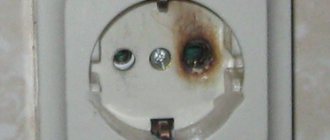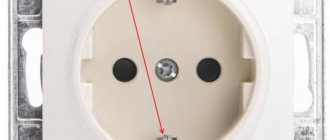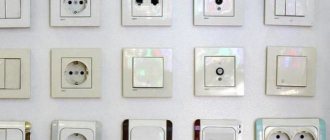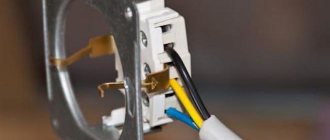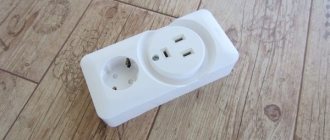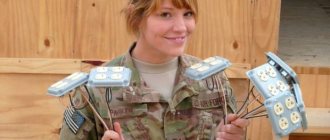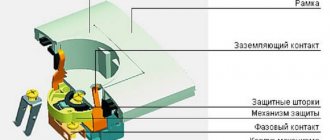When can you install overhead sockets?
Surface-mounted sockets
To make a choice and select the right devices, you need to understand what the main differences between surface-mounted (external) type devices and internal ones are. The most significant points:
- For the first type of sockets, all the key parts are located inside the plastic case.
- Overhead models do not require surface scoring.
- External devices do not require an additional niche or socket box.
When developing the initial plan, such access points are usually not provided if it is possible to make built-in, less noticeable devices. The disadvantage is the significant “bulge” relative to the wall. However, in some cases, an external outlet is the only option:
- The finishing work has been completed, but there is a need for an access point to the power grid in a new location.
- The coating does not require gating: tiles, tiles, panels.
- The thickness of the walls makes it impossible to hide devices and wires.
Users and professionals note some disadvantages during operation. For example, rapid wear and loss of the original appearance of equipment. If damaged, you can get an electric shock - all key elements are outside.
Recommendations for location and use
An outdoor socket is considered an excellent option for private residential buildings and outbuildings: barn, garage, greenhouses, outdoor kitchen, other open areas). For such structures it makes no sense to lay a separate cable and conduct electrical wiring. Devices and wires are attached to small nails.
When installing an external grounded outlet, it is necessary to take into account the traffic flow of the room. The device should not be secured near door frames; it is advisable to “cover” it with furniture: for example, behind a desk or dining table - access and additional protection.
What you need to know before installation
Remember that the kitchen is a high-risk place because there is water and fire. To avoid negative consequences, make sure that the sockets have the appropriate level of protection.
The installation locations of sockets in the kitchen are selected depending on the location of electrical appliances. For example, near a table or kitchen cabinet.
Important! It is worth remembering that kitchen electrical appliances have high power. Therefore, choose an outlet that is designed for this load level to prevent a fire.
Electrical socket device
The overhead socket has a simple structure, which differs little in different models. Required elements:
- The case is an external protective part, made of plastic: it burns quickly, it is cheap and releases toxins when heated; polycarbonate: the best option – heat-resistant, durable; ceramics: more reliable, does not heat up, minus – fragility. Current-carrying elements are attached to the inside.
- The direct mechanism is brass or bronze elements in a complex. The latter are extremely rare, but more reliable. Mandatory part - grounding: protects equipment and users from electric shocks.
- The panel is an external part that defines the design. In most cases, they are made of polycarbonate; expensive “designer” models can be made of glass, wood, metal and other materials.
The double external socket has no distinctive elements. Thanks to a simple device without the need for gating and finishing, self-installation is possible without the involvement of professional electricians.
Electrical outlets with additional options
There are electrical outlets in every home, office, and workplace. They are even found in outbuildings and free-standing toilets. And it is not surprising that manufacturers are trying to diversify their range. There are some very interesting options.
There are sockets with lighting - LEDs light up when the plug is connected, and there are also ones with funny faces
With power monitoring functions
When overhauling wiring or when laying new networks, lines are laid according to modern requirements - through circuit breakers, with the installation of RCDs, stabilizers, etc. on the necessary lines. But there are many homes in which the wiring is several decades old. It is quite functional, but the only means of protection and control are a couple of plugs or automatic machines at the entrance to the house/apartment. Safety problems can be solved, at least for the most sensitive and expensive devices, by installing an electrical outlet with voltage control or an RCD.
There are models that can serve as decorations
Electrical socket with built-in RCD . Powerful household appliances should be connected to dedicated lines, on which there should be circuit breakers and RCDs. If there is nowhere to install them in the panel, you can install an electrical outlet with an RCD. When a leakage current appears in the line or on a connected device (occurs due to an insulation breakdown or if someone touches exposed live wires), the protection will operate and the RCD will turn off the power.
Electrical sockets with built-in RCD are designed for a leakage current of 10 mA
With overvoltage protection. Our networks often experience power surges. If there is no general or local voltage stabilizer, and the equipment connected to the outlet will be sensitive to the quality of the power supply and expensive, you can install an outlet with surge protection. If the threshold voltage is exceeded (different models have different thresholds, but usually it is 275 V), the power is turned off.
Sockets with surge protection relays are a useful feature for sensitive equipment
With increased ease of use
“Advanced” models of electrical outlets provide additional features that can solve many problems.
With timer . Convenient thing. You turn on some device, set the time after which it needs to be turned off and that’s it. At the right moment, a special mechanism will open the contact and the device will turn off.
Electrical sockets with timer - mechanical and electronic
The simplest sockets are with a mechanical timer (pictured above on the left), but there are also electronic ones. And the electronic one can also be programmable, in which you can set a schedule for turning on and off.
With extension cord . We often encounter the need to use an extension cord. You can use a regular one, but there are sockets with a built-in extension cord. Of course, you need a large cavity in the wall for them, but you will never lose such an extension cord, i.e. the storage problem is solved. When folded, the cord is wound onto a drum hidden in the wall, and the socket is used as usual. You need an extension cord - just pull it, if not - pull it a little towards you and the wire will rewind.
Electrical outlet with built-in extension cord
In addition to regular extension cords, there are models with an extension cord and a tee. One socket remains on the wall, two are moved on a cord. It's also a convenient thing.
Childproof
There are two types of childproof electrical outlets. In one, the holes into which the fork is inserted are closed with protective curtains, which are retracted only if pressure is applied to both curtains at the same time. Moreover, you need to press with a certain amount of force, which a small child is simply not able to develop. An electrical outlet with protective curtains is not much more expensive than a regular one, but is reliable protection against children.
Electrical outlet with child protection - you can use more than just plugs
The second type of electrical outlets with child protection is with rotating curtains. To insert a plug into such a socket, you need to pry the curtains with the pins of the plug and turn them to a certain angle. Then the holes in which the contacts are located will open.
Design features
Electronics and electronic devices are increasingly becoming part of our everyday lives. Probably everyone has already heard about the “smart home” system. But probably few people know that there are electrical sockets that can be controlled from a mobile phone. Using a smart socket, you can, for example, remotely turn on and off an electric fireplace in your country house. You can also turn off the iron if you accidentally left it on when leaving home.
There are other, not so exotic models.
There are different electrical outlets, with different functions and additional devices.
With USB port (connector) . We already have so many electronic devices that need recharging that it is necessary to organize separate socket blocks for them or install USB hubs. Another option is to install an outlet with a USB port/connector or several. In one building there can be from one to four or five.
With built-in USB ports
Combined with a switch. Not only several sockets, but also switches can be installed in one housing. Since the installation height of switches has recently been low - at the level of the lowered hand (85-95 cm from the floor), sockets there are quite appropriate. And through such models you can turn on the lamps. For example, wall sconces or lamps on bedside tables. It will be convenient to turn the lighting on/off, and there will also be somewhere to connect the charger.
In one housing with a switch
With lids. There are also sockets with protective covers. They are often placed outdoors or in a dusty room to prevent dust and dirt from settling on the contacts. Most often they are found with lids that rise upward, which are raised when you need to turn on the device - the lid remains raised until you pull out the cord. The lid itself may or may not be transparent.
Electrical socket with cover: there are several types
There are rotary models in which the lid opens to the side, like a door (in the figure above on the right). And it opens only to insert a plug. Then the lid can be closed, since there is a special recess for the cord. Such “draconian” measures are needed for places with very dusty production.
Design varieties
A variety of types of equipment requires a corresponding number of types of surface-mounted sockets with grounding. This is especially striking for travelers - there are twelve standards for the production of such devices. For example, devices with plugs from Russia cannot be used in Israel, England, Switzerland and many other countries.
An important point is the technical characteristics: voltage, frequency. The classic version - a surface-mounted double electrical socket with a rating of 220 Volts - is intended for devices with a power of up to 3.5 kW. The limitation is caused by the fact that household equipment cannot cope with current strength above 16A.
Also, power access points vary in number per modular unit. Single and double sockets are often used, less often triple and quadruple.
Modern devices are complemented by related functions. For example, they build in an RCD or equip it with special curtains that hide the holes from children and dust.
Degree of protection
The level of protection for sockets indoors and outdoors is different. On the case it is indicated by the letters IP and numbers. The first is protection from solid contaminants, the second – from liquid contaminants. It is important to take these parameters into account when installing devices outdoors, in rooms with high humidity (sauna, bathroom). Suitable data ranges from IP44 to IP68.
Table of degrees of protection
A surface-mounted socket with a cover is more suitable for installation outside a building, especially if it is planned to be used infrequently. It is forbidden to buy cheap options - low-quality materials with a low safety margin can lead to fire, short circuit, and other problems.
What types of overhead sockets exist?
These devices have several varieties, depending on their purpose and area of application. Below we will discuss some commonly used types with specific examples. So, overhead sockets are classified as follows:
- Socket specifically designed for computer networks (computer overhead socket RJ-45 Electric);
- Regular power (Viko surface-mounted electrical socket);
- TV socket (TV socket Schneider);
- Telephone socket (RJ 11).
These devices are also divided into types according to the level of protection, which is usually written on the device body. IP20 means the socket is unprotected and is suitable for a normal room. IP66 makes it clear that the device is protected from water and dust.
Socket selection
Before purchasing, you need to find out the voltage and current values in the existing network. An important point is the method of fixing the cables. Screw-type ones are more durable, keyboard ones weaken quickly. Device categories:
- single – size height/width up to 7/5 cm, one plug;
- corner;
- double – connectors for two plugs;
- sockets with additional protection: curtains that automatically close entrances;
- decorative models - thin, of different shapes, colors, materials.
Double sockets with grounding are selected in accordance with the conditions of use and the performance of the electrical network.
Installation of sockets
Wires are routed to the outdoor unit without cutting into the walls and are secured with small nails with hooks. Special plastic channels protect from damage. They are secured at the bottom with plinths with recesses to accommodate cables. Recommendations for laying:
- cannot be installed near heating devices or stoves;
- from water sources - at least 30 cm;
- the height is calculated taking into account the needs of the users.
Recently, sockets are often installed near switches.
Power outage
Compliance with safety standards and requirements is the first point. The area where the outlet will be connected and installed should be de-energized. The power is turned off on the landing; if the installation is carried out in an apartment, the machine switches are switched to the “off” position.
If you are in doubt about the correct plug, you need to turn off each one one by one and check the presence of electricity in existing sockets and switches.
Site marking and preparatory activities
You need to prepare the socket: remove the top cover, move the latches (for example, with a screwdriver). Then the device is divided into parts - the panel, the main mechanism and the body.
First of all, places for fixing holes are marked on the wall. You can level it using a special device - a level. Marks are made with a pencil, then connectors are made (drill, drill bit). Dowel nails are used for concrete walls, and screws are used for wooden coverings.
Attaching the working part
After preparing the holes, you can begin to directly secure the socket. The mechanism is installed and aligned, secured with dowels and screws. Check the tightness of the base - pull, move. There should be no distances or movements.
Preparing the wires
Cable - fastening and wiring - one of the most critical stages in connecting an outlet. The wires inside must be stripped at least 1 cm until a metal core appears. The device has three types of wires:
- phase - red, sometimes black or brown;
- zero - blue, blue and white;
- for grounding - green and yellow.
Prepared cables are routed through the recesses in the housing and, if necessary, shortened to the required length.
Terminal design features
Terminals are special clamps or screws that press the exposed part of the cable product to the conductive plate. It is better to choose sockets with screw terminals. Clamping devices quickly fail - due to constant pressure they weaken, resulting in loss of contact. It is no longer possible to fix such an outlet; a complete replacement is required.
Connecting the mechanism
If only two guide cables are installed in the building wiring - phase and neutral - the third will remain unclaimed. The outlet cannot be grounded. If there is a three-wire wire, it is necessary to determine the grounding wire and insulate it.
Cables are connected by color. The correct connection can be checked using a multimeter or other similar devices.
Installing the cover
The external panel is attached differently, depending on the type of outlet installed. The classic version – a white plastic block – needs to be placed over the body and pressed until it clicks.
Checking the work is the final stage. They turn on the circuit breakers on a common house transformer, check the contacts with a special device or by directly turning on the equipment. In the second case, if connected incorrectly, the device may burn out.
Installing an outlet is a simple procedure. If you first familiarize yourself with the rules and safety requirements, study the structure of the device, anyone can connect an additional external power source.
Overhead sockets for the kitchen
Sockets in this room are located on three levels:
- First level. Serves to connect large appliances (washing machine, electric stove, etc.). The installation height of the socket is 15 cm.
- Second level. Necessary for small electrical appliances that will need to be moved frequently (kettle, mixer, toaster, etc.) Sockets are placed at a height of 110 to 130 cm.
- Third level. Suitable for electrical appliances such as hoods. The height of the rosettes is 200-250 cm.
